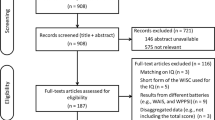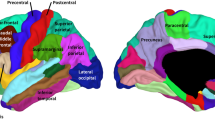Abstract
The role of structures of the left and right cerebral hemispheres in formation of speech function and memory was studied on the basis of complex examination of children with developmental speech disorders. On the basis of EEG estimation of the functional state of the brain, children were classified in two groups depending on the side of localization of changes in electrical activity: those with local changes in electrical activity in the left hemisphere (group I) and those with changes in the right hemisphere (group II). The medical history suggested that the observed features of topography of local changes in electrical activity were linked with the character of prenatal and labor complications and their consequences leading to embryo- and ontogenetic disorders in development of different brain regions. Comparison of the results of neuropsychological examination of the two groups showed that different regions of the brain cortex of both the left and right hemispheres are involved in speech formation. However, a specific role of the right hemisphere in formation and actualization of automatic speech series was revealed. It was suggested that the integrity of gnostic functions of the right hemisphere and, primarily, the spatial organization of perception and movements is a necessary factor of development of auditory–speech and nominative memory.
Similar content being viewed by others
REFERENCES
Luria, A.R., Osnovy neiropsikhologii (The Foundations of Neuropsychology), Moscow: Mosk. Gos. Univ., 1973.
Khomskaya, E.D., Neiropsikhologiya (Neuropsychology), Moscow: Mosk. Gos. Univ., 1987.
Farber, D.A., Beteleva, T.G., Gorev, A.S., et al., Functional Organization of Developing Brain and Formation of Cognitive Activity,Fiziologiya razvitiya rebenka (Physiology of Development of a Child), Farber, D.A. and Bezrukikh, M.M., Eds., Moscow: Obrazovanie ot A do Ya, 2000, p. 82.
Skvortsov, I.A., Simernitskaya, E.G., Moskovichute, L.I., et al., Metodika adaptirovannogo neiropsikhologicheskogo issledovaniya dlya detskikh nevropatologov. Metodicheskie rekomendatsii (A Technique of Adapted Neuropsychological Examination for Children's Neuropathologists. Methodological Recommendations), Moscow: MZ RF, 1988.
Shklovskii, V.M., Lukashevich, I.P., Machinskaya, R.I., et al., Some Pathogenetic Mechanisms of Developmental Speech Disorders in Children, Defektologiya, 2000,no. 2, p. 20.
Odinak, M.M., Mikhailenko, A.A., Sivanov, Yu.S., et al., Sosudistye zabolevaniya golovnogo mozga (Brain Vascular Diseases), St. Petersburg: Gippokrat, 1997.
Lukashevich, I.P., Shipkova, K.M., and Shklovskii, V.M., Structural Approach to Presentation and Analysis of Neuropsychological Information, Med. Tekhn., 1998, no. 5, p. 18.
Lukashevich, I.P., Machinskaya, R.I., and Fishman, M.N., Automated Diagnostic System “EEG-Expert,” Med. Tekhnika, 1999, no. 6, p. 29.
Bailey, N.T.J., Statistical Methods in Biology, Oxford: The English Univ. Press Ltd., 1959. Translated under the title Statisticheskie metody v biologii, Moscow: Inostrannaya Literatura, 1962.
Chiron, C., Pinton, F., Masure, M.C., et al., Hemispheric Specialization Using SPECT and Stimulation Tasks in Children with Dysphasia and Dystrophia, Dev. Med. Child Neurol., 1999, vol. 41, no. 8, p. 512.
Machinskaya, R.I., Lukashevich, I.P., and Fishman, M.N., Dynamics of Brain Electrical Activity in 5-to 8-Year-Old et al. Children in Norm and during Learning Problems, Fiziol.Chel., 1997, vol. 23, no. 7, p. 5.
Badalyan, L.O., Detskaya nevrologiya (Children's Neurology), Moscow: Meditsina, 1984.
Ratner, A.Yu., Pozdnie oslozhneniya rodovykh povrezhdenii nervnoi sistemy (Late Complications of Lesions of the Nervous System at Birth), Kazan: Kazan. Gos. Univ., 1990.
Blinkov, S.M. and Glezer, I.I., Mozg cheloveka v tsifrakh i tablitsakh (Human Brain in Figures and Tables), Leningrad: Meditsina, 1964.
Aram, D.M., Meyers, S.C., and Ekelman, B.L., Fluency of Conversational Speech in Children with Unilateral Brain Lesions, Brain Lang., 1990, vol. 38, no. 1, p. 105.
Thal, D.J., Marchal, V., Stiles, J., et al., Early Lexical Development in Children with Focal Brain Injury, Brain Lang., 1991, vol. 40, no. 4, p. 491.
Simernitskaya, E.G., Dominantnost' polusharii (The Dominance of Hemispheres), Moscow: Mosk. Gos. Univ., 1985.
Woods, B.T., Dichotic Listening Ear Preference after Childhood Cerebral Lesions, Neuropsychologia, 1984, vol. 22, no. 3, p. 303.
Wada, J.A., Clarke, R., and Hamm, A., Cerebral Hemispheric Asymmetry in Humans. Cortical Speech Zones in 100 Adults and 100 Infant Brain, Arch. Neurol., 1975, vol. 32, no. 4, p. 239.
Cernacek, J., Morphological Correlates and Heredity in Functional Asymmetry of the Cerebral Hemispheres, Bratisl. Lek. Listy, 1989, vol. 90, no. 11, p. 831.
Mount, R., Reznick, J.S., Kagan, J., et al., Direction of Gaze and Emergence of Speech in the Second Year, Brain Lang., 1989, vol. 36, no. 3, p. 406.
Dehaene-Lambertz, G., Cerebral Specialization for Speech and Non-speech Stimuli in Infants, J. Cogn. Neurosci., 2000, vol. 12, no. 3, p. 449.
Cousino, M.E. and Restatter, M.P., Reaction Times of Four Year Old Children to Monaurally Presented Verbal Stimuli: Some Evidence for Right-Hemisphere Linguistic Function, Cortex, 1985, vol. 21, no. 3, p. 445.
Springer, S. and Deutsch, G., Left Brain, Right Brain, San Francisco. Translated under the title Levyi mozg, pravyi mozg, Moscow: Mir, 1983.
Simernitskaya, E.G., Mozg cheloveka i psikhicheskie protsessy v ontogeneze (Human Brain and Mental Processes in Ontogeny), Moscow: Mosk. Gos. Univ., 1985.
Author information
Authors and Affiliations
Rights and permissions
About this article
Cite this article
Lukashevich, I.P., Machinskaya, R.I. & Shklovskii, V.M. Role of the Right- and Left-Hemispheric Structures in Speech and Memory Formation in Children. Human Physiology 28, 682–686 (2002). https://doi.org/10.1023/A:1021148222052
Issue Date:
DOI: https://doi.org/10.1023/A:1021148222052




